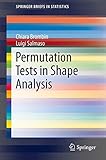Permutation Tests in Shape Analysis / by LUIGI SALMASO, Chiara Brombin.
Tipo de material: TextoSeries SpringerBriefs in Statistics ; 15Editor: New York, NY : Springer New York : Imprint: Springer, 2013Descripción: x, 95 páginas 19 ilustraciones, 16 ilustraciones en color. recurso en líneaTipo de contenido:
TextoSeries SpringerBriefs in Statistics ; 15Editor: New York, NY : Springer New York : Imprint: Springer, 2013Descripción: x, 95 páginas 19 ilustraciones, 16 ilustraciones en color. recurso en líneaTipo de contenido: - texto
- computadora
- recurso en línea
- 9781461481638
- QA276-280
Springer eBooks
Statistical shape analysis is a geometrical analysis from a set of shapes in which statistics are measured to describe geometrical properties from similar shapes or different groups, for instance, the difference between male and female Gorilla skull shapes, normal and pathological bone shapes, etc. Some of the important aspects of shape analysis are to obtain a measure of distance between shapes, to estimate average shapes from a (possibly random) sample and to estimate shape variability in a sample[1]. One of the main methods used is principal component analysis. Specific applications of shape analysis may be found in archaeology, architecture, biology, geography, geology, agriculture, genetics, medical imaging, security applications such as face recognition, entertainment industry (movies, games), computer-aided design and manufacturing. This is a proposal for a new Brief on statistical shape analysis and the various new parametric and non-parametric methods utilized to facilitate shape analysis.
Para consulta fuera de la UANL se requiere clave de acceso remoto.


